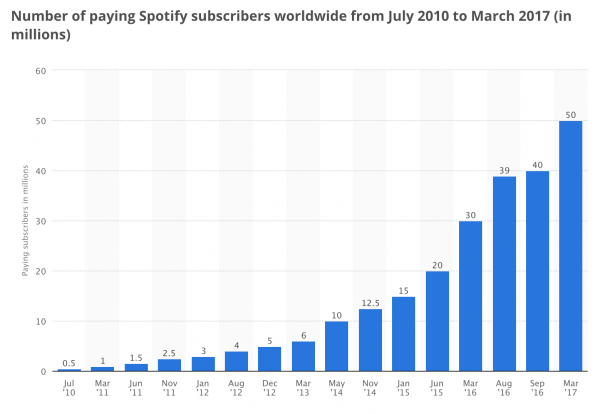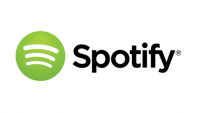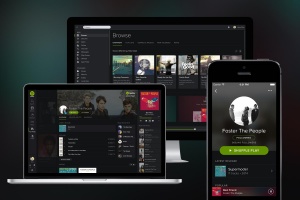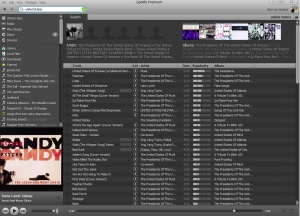Spotify
|
Spotify is an online music streaming service, enabling users to listen to full-length tracks from a variety of major record labels and artists. Founded in 2006 in Sweden and later launched in 2008, Spotify garnered a following and eventually launched in the United States in July of 2011, partnering with Sony Music Entertainment, EMI Group, Warner Music Group, Universal Music Group, and the Orchard and Merlin. Designed primarily as a desktop application, Spotify is similar to Apple Inc.'s iTunes in terms of visual aesthetics and functionality, but recently launched mobile application support for iOS and Android devices. However, unlike iTunes, Spotify allows its users to listen to full-length tracks or create playlists with them without purchase. In addition, users can view their Facebook friends' playlists and share their own playlists. [2] The platform itself has presented ethical dilemmas surrounding Spotify's non-transparency with its terms of use as well as a data breach that exposed the personal information of millions of users.
Upon its inception, when activating a Spotify account, the user was provided a free six-month trial period, which is sustained by visual and radio advertisements. After this trial period expires, Spotify provides users with 10 hours of listening time per month partitioned into 2.5 hours per week. Now, Spotify has unlimited streaming services for regular members, with advertisements. Spotify offers a Premium subscription, which allows users to listen to music offline on their mobile device after they download it and increases their bit-rate streaming. It also makes the experience advertisement free. Spotify users can browse Spotify's 20 million songs by genre, record label, album, artist or song. [2] In June 2015, Spotify was valued at over 8 billion dollars. [3]
Contents
History
Spotify was founded in April 2006 by Daniel Elk and Marin Lorentzon in Stockholm, Sweden. The website was launched for public access on October 7th, 2008. Select users were given free accounts and could invite a limited number of other users to create accounts. These users were given Spotify Free accounts. The general public in the United Kingdom could open accounts, specified as Spotify Open accounts, without invitations beginning in February 2009. However, due to the unanticipated surge in new accounts, Spotify had to limit registration to "by invitation only" again. On April 14th, 2011, Spotify announced a change in the amount of music Spotify Open and Spotify Free users could stream. [4] Spotify was not launched in the United Sates until July 14, 2011, and now requires new users to sync their account with their Facebook account.[1] Spotify is also available as a downloadable app for iPhone and Android for mobile access. In February 2011, Spotify was valued at $1 billion and in November 2012, Spotify was valued at $3 billion. [5][6] As of December 2012, Spotify has 20 million users, of which 5 million are paying users, and 1 million of those paying users are located in the United States[7]
As of March 2016, Spotify had approximately 30 million paying subscribers. [8]
Features
Playlists
Playlists can be created in Spotify by dragging selected songs into a specific group, which is saved to the user's account and can be accessed instantly from any device with Spotify downloaded. There can be up to 10,000 tracks on a single playlist. [9] Users can drag and drop songs or entire albums to create a playlist. Playlists can be shared with friends by emailing or instant messaging a link to the playlist. Upon following the link, the shared playlist is added to that user's library. Playlists can also be shared through social networking sites like Facebook.
Users also have the choice to follow or save a pre-made playlist. This can be through Spotify's own recommendation based on what is trending, a user's mood, or new releases. There is also the opportunity to search a specific genre, artist, album, or another playlist that can then be added to a personal playlist. Users have the option to search and follow other users or artists and save or follow their playlists too.
Limitations
Artists can choose to withhold their music from Spotify, disabling users' ability to search for it. In some situations, the music will appear, but users will not be able to listen to it. Examples include some Disney albums like the soundtrack to the movie, Aladdin. Two tracks, "Friend Like Me" and "Prince Ali" are both withheld from Spotify. Another example is Adele's most recent album, "21", which did not release any of its songs to Spotify for several months after their release. The witholding of music from Spotify is predominately because Spotify still has not acquired licenses to play certain record labels' music.
Mobile
Spotify can currently be accessed from a variety of mobile devices including any Apple iOS, Android, Blackberry and Windows mobile. To use Spotify on a mobile device, the user must subscribe to the premium service for $9.99 per month. There have been some complaints about the mobile app. Users cite problems with syncing their devices as well as the app frequently crashing. Other complaints with the mobile app include the inability to explore Spotify's vast library. Users are forced to build playlists of desired songs instead of searching for them on-the-fly if for instance, they are playing music while driving. Critics of the app say that the developers are poor programmers and need to find better ways for users to search for songs along with accessing the "top" sections of tracks, artists and albums.
Social Networking
Spotify has integrated social networking into their player, allowing users connected to Facebook, to share playlists with their friends, and post favorite songs to the site. Through Facebook, two friends can collaborate and make a playlist and then share their playlist to other friends. This is one of the main differences between Twitter and its competitors. By being able to see playlists of your friends on Facebook, it is the one of the first big social media music applications. With the music posts features, instant playback is available on Facebook. Posting favorite songs to Twitter is also possible.
Offline mode
Spotify can be accessed without an Internet connection using the offline mode feature with a premium account. This enables the user to choose specific songs or playlists that sync to the computer or device allowing playback anywhere, including subways, airplanes, boats, and beaches. Users must download these songs and playlists while they are online. Songs and playlists are stored in the computer's cache for later playback. You can play up to 3,333 songs offline on 3 different devices. The mobile client also has a "Force Offline" mode which immediately stops Spotify from using the Internet. This can be especially useful for preserving battery life and data usage[10].
Apps
On November 30, 2011, Spotify Apps were announced[11]. The list of supported apps at the time of the announcement include Last.fm, We Are Hunted, Rolling Stone, The Guardian, Pitchfork, Tunewiki, and Songkick.[11] This feature will allow third-party and independent developers to bulid HTML5-based apps to supplement the Spotify service. Some of the expected tools will offer extra information regarding music recommendations, concerts, lyrics, and news.[12] Spotify Apps intro video
Apps are sectioned to the left under the first heading titled "APP". The Appfinder, TopLists, and Radio apps are defaulted into the section, but users are free to add and delete apps from the Appfinder. When a user adds an app, it is automatically added to the App section on the left where users can click and use it as they listen to music.
iTunes on Spotify
Upon signing up, Spotify scans your hard drive for MP3s and other digital music files. Spotify will detect the tracks individually, but is also capable of transferring the playlists you've previously created into your new Spotify library. If you do not wish to have your entire iTunes library imported, you can selectively import playlists from iTunes by going to File, selecting Import Playlists, then iTunes. The playlists for you to select will then appear on the left sidebar of Spotify. [13]. When searching through Spotify's online mode, the name of the artist for any songs that the user currently owns on their hard drive will appear in a darker grey color, or with a music note icon on the side.
Membership

Spotify offers Four different membership options to its users: Spotify Free, Spotify Premium, Spotify Premium for Students, and Spotify Family[15]. As of March 2017, Spotify has 50 million paying subscribers – up from 30 million the same time in 2016[14].
Spotify Free
Spotify Free is Spotify’s most basic streaming package. Streaming quality can range from 96 to 160 kbps depending on the user’s internet connection and device of choice. The package allows users to listen to all of Spotify’s tracks over an internet connection as well as create, edit, and share your own playlists. Listening is unlimited but users are subject to a few restrictions. On desktop, users are able to select specific songs and switch between them freely with adds playing intermittently. On mobile, users are limited to “Shuffle Play” where they can listen to playlists only and are unable to select specific songs. Mobile users are also limited to six track skips per hour. Like desktop users, mobile users are subject to intermittent ads that cannot be skipped or muted. Attempting to mute ads or even make them noticeably quieter only pauses the ad until the users turns the volume back up[16].
Spotify Premium
Spotify Premium, priced at $9.99/month, is Spotify’s most advanced streaming package. Streaming quality can range from 96 to 320 kbps depending on the user’s internet connection and device of choice. The package provides users all the perks of the “Free” package but with no limitations. Users are free to select specific songs, play them on repeat, and skip songs as often as they want. Users are also guaranteed a completely ad-free listening experience[17].
Spotify Premium also introduces a number of completely new features. “Spotify Connect” allows users to use their mobile Spotify app as a controller for over 300 different devices. By syncing devices over Wi-Fi connections users can control what their account plays on devices ranging from the Playstation 4 to the Amazon Echo[18]. “Offline Listening” is another feature available for premium users. This feature allows users to download up to 3,333 Spotify songs on up to three devices and listen to them later when they are not connected to the internet. This offline listening function allows users to not burn through their data when streaming music as the songs are already downloaded on the application on a user's phone. [19].
In April 2017, Spotify announced that Premium users would soon begin to have access to select albums and singles two weeks before Spotify Free users[20].
Spotify Premium for Students
Spotify Premium for Students, priced at $4.99/month, offers all of the features of Spotify Premium at a discounted price. With the Spotify student discount, students can get 50% off a premium subscription. Users are able to receive this discount by registering for Spotify with a valid student email account. The discount is only valid for 12 months at a time, as each year students must re-sign up to continue to receive the discount. This offer is only offered for four consecutive years and then the price is back up to $9.99/month. [21].
Spotify Family
Spotify Family, priced at $14.99/month, offers all of the features of Spotify Premium with the added possibility for multiple users under once account. Spotify Family’s $14.99/month charge is constant and supports up to six users, so long as those users are family living under the same address. Each member of the family is given their own Premium account so users won’t have to share songs, playlists, or have to worry about multiple users being on the same account[22].
Ethical Issues
There have been continuous debates about the ethical rights of Spotify. Not just by major labels and signed artists, but indie artists, and consumers themselves.
Ethical Concerns for Artists and Labels
The ethical question at hand is how much compensation artists should receive for streaming their music through services like Spotify. Most experts would say that the question of “compensation” cannot be answered accurately because Spotify doesn’t pay artists directly. Some artists say that they receive on average of between $0.0006 and $0.0084 per play. Others offer different estimates, and less popular artists may make less money per play. [23] The publishers, copyright holders, and record labels get the money depending on terms of condition. Patrick Carney of the band The Black Keys spoke out against Spotify board member Sean Parker (creator of Napster), "That guy has $2 billion that he made from figuring out ways to steal royalties from artists, and that’s the bottom line. You can’t really trust anybody like that. The idea of a streaming service, like Netflix for music, I’m totally not against it. It’s just we won’t put all of our music on it until there are enough subscribers for it to make sense." [24] The Black Keys have since allowed the streaming of their entire music catalogue, after popularity of Spotify had risen. Other members of the music industry have spoken out against Spotify, claiming that the service fails to compensate artists properly. However the company has claimed to have paid out over 100 million dollars worth of revenue to the music rights holder.[25] Other prominent artists such as Taylor Swift and Adele have recently cut some or all ties with Spotify, releasing albums solely on iTunes for full purchase. A large part of the issue is that labels receive money from Spotify, but fail to compensate their artists because there are no contractual terms of how much they will be compensated from this specific service, a very similar situation to the Writer's Strike in 2007, when studios failed to compensate their writers more for new earnings from new media (online download, streaming, on demand).[26]
There are also indirect effects on the success of artists, separate from compensation paid directly to the publishers, copyright holders, and record labels that are hard to quantify. For example, Spotify's integration with Facebook, which has been a large cause for the software's success, provides self-sustaining marketing for any artist whose song is played. If a user has 50 Facebook friends online, and the Facebook ticker displays that he is listening to a song, those 50 users have been exposed to the artist, which will result in some expected value of sales for the label.
Fighting Piracy
Spotify offers the ability to download your iTunes playlists, as described above. This is to help convenience the buyer to have all their songs in one place. While this helps to limit privacy due to the inability to share your local files among other users, it may encourage people to continue pirating songs in order to add them to their Spotify playlists. Again, Spotify combats the ability to share the file to prevent illegal file sharing. To limit piracy all together, Spotify should continue to expand their library. Spotify also offers offline mode so people can listen to music while not connected to the internet. Spotify has offered many features to limit privacy. There are still ways around this however, like Soundiiz, a website that converts online playlists to Youtube files. One can then use a Youtube to mp3 converter. Spotify's many efforts to reduce piracy have paid off however.
One thing that Spotify has done is educate its users on piracy. Using short advertisements, Spotify informs listeners that use of Spotify is not piracy, and that they properly compensate the artists you listen to. As a result of this brief education of piracy, Spotify has made a significant contribution in reducing piracy. In 2009, piracy in Sweden (where Spotify originated) dropped by 25% just one year after Spotify was launched [27]. Many contribute this downward trend of piracy to the popularity of legal music streaming services, namely Spotify.
Privacy Issues
Transparency
While a Facebook account is not required in order to use the Spotify application, there are concerns regarding the Terms of Service for Spotify users who do choose to use their Facebook account. The application defaults to a service where all of a user's activity on the application is posted to their profile, but many people do not read the Terms and do not realize this. Often times, new users are upset by this lack of transparency and notification of the application's actions. Spotify eventually allowed users to manage their own Facebook privacy settings and not "connect" their accounts to post on their Facebook pages. However, there have been many complaints that this is difficult to do and settings get mysteriously reset on timeouts. Because of this, some users even make complete new Facebooks so that they can dedicate an account to listen to Spotify without having every song shared publicly on Facebook. Secondly, some people are concerned that in order to use the application they must agree that information and data about them and their listening habits is being gathered and could be used by record labels and marketers to sell them their products. Initially, there were privacy issues with Spotify on Facebook include the ability for a user's Facebook friends to be able to see what artists, tracks, and music you are listening to while using Spotify, but Spotify has added a feature to disable sharing updates on Facebook for those who have these concerns.
Data Breach
On March 4, 2009 Spotify issued a privacy notice to all of its users stating that security protocols had been breached possibly leading to unwanted access to private user information like passwords and email addresses.[28] The problem existed when users added another users shared playlists, leading the the Spotify software requesting private information from the Spotify servers. The servers would then return information about the original author of the playlist, potentially compromising that person's security.[29]
Vulfpeck, Sleepify
In 2014, funk band Vulfpeck released an album on Spotify called Sleepify, consisting of nothing but thirty-second silent tracks. Vulfpeck encouraged their fans to stream the album while they slept so the band could collect royalties to fund their upcoming tour. With these funds, Vulfpeck promised to offer free admission to their fans [30]. Sleepify was available to stream for seven weeks, before Spotify removed the album, claiming it violated their terms of content. In that time, Vulfpeck accumulated roughly $20,000 in royalties from Sleepify, and was able to successfully six shows free of charge to their fans.[31][32]
See Also
External Links
References
- ↑ 1.0 1.1 Spotify on Wikipedia
- ↑ 2.0 2.1 Spoty. "About us." Retrieved on 16 April 2016.
- ↑ Davidson, Lauren.Spotify Valued at $8.53bn Valuation After Fresh Funding Round." 10 June 2015. Retrieved on 16 April 2016.
- ↑ White, Jer."Spotify Free vs. Spotify Open." 2011. Retrieved on 16 April 2016.
- ↑ Sorkin, Andrew Ross and Rusli, Evelyn M. "Spotify Raises New Investments at 1 Billion Valuation." 21 February 2011. Retrieved on 16 April 2016.
- ↑ Bradshaw, Tim. "Spotify in Top League with $3bn valuation." 15 November 2012. Retrieved on 16 April 2016.
- ↑ O'Brien, Terrence. "Spotify doubles user base in last year, 1 million paid subscribers in the US." 6 December 2012. Retrieved on 16 April 2016.
- ↑ Statista."Number of paying Spotify subscribers worldwide." Retrieved on 16 April 2016.
- ↑ Spotify. Dummys Retrieved on 24 April 2016.
- ↑ Spotify."Spotify Offline Mode." Retrieved on 16 April 2016.
- ↑ 11.0 11.1 Spotify. "Say Hello to Spotify Apps." 30 November 2011. Retrieved on 16 April 2016.
- ↑ Spotify Apps
- ↑ Dummies.com. "How to Manage Spotify and iTunes Playlists." Retrieved on 16 April 2016.
- ↑ 14.0 14.1 Spotify; Tech Crunch. Number of paying Spotify subscribers worldwide from July 2010 to March 2017 (in millions)'. March, 2017. "Statista"
- ↑ Spotify. Go Premium - Spotify. 2017. "Spotify"
- ↑ Spotify. Spotify Free. 2017. "Spotify"
- ↑ Spotify. Go Premium. Be happy. 2017. "Spotify"
- ↑ Spotify. Spotify Connect. 2017. "Spotify"
- ↑ Spotify. Listen Offline. 2017. "Spotify"
- ↑ Singleton, Micah. Spotify Premium users will get some albums two weeks before free users. 4, Apr 2017. "The Verge"
- ↑ Spotify. Spotify Premium. Only $4.99 for students. 2017. "Spotify"
- ↑ Spotify. Up to 6 accounts. Just $14.99 per month. Premium for Family. 2017. "Spotify"
- ↑ Keating, Lauren "Here Are The Artists You Won’t Find On Apple Music, Tidal and Spotify." 3 July 2015. Retrieved on 16 April 2016.
- ↑ Makarechi, Kia. "Black Keys: Sean Parker is an A**hole, Spotify isn't Fair to Artists." 28 March 2012. Retrieved on 16 April 2016.
- ↑ Hypebot. "Spotify Offers Additional Reponse to Independent Label Defections." 1 September 2011. Retrieved on 16 April 2016.
- ↑ Wikipedia. Writers Guild of America Strike." Retrieved on 16 April 2016.
- ↑ Ernesto."Music Piracy Continues to Decline Thanks to Spotify." 28 September 2011. Retrieved on 16 April 2016.
- ↑ Spotify. "Spotify Security Notice." 4 March 2009. Retrieved on 16 April 2016.
- ↑ DeSpotify. "Criticism." Retrieved on 16 April 2016.
- ↑ https://www.youtube.com/watch?time_continue=60&v=KXvncV79LXk
- ↑ https://noisey.vice.com/en_uk/article/youneedtohearthis-the-band-that-cheated-spotify-have-been-banned-from-spotify-sleepify-vulfpeck
- ↑ https://www.facebook.com/vulfpeck/posts/748705795175214



